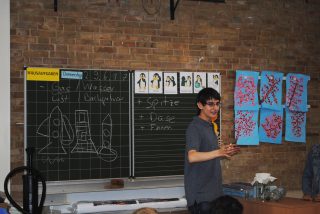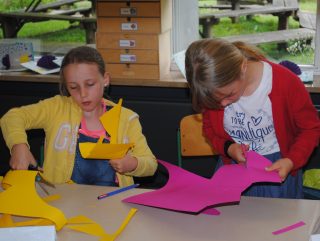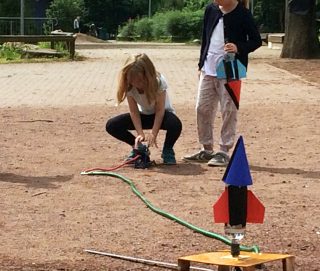With happy faces, 22 first graders gazed at the sky when their first self-constructed rocket launched. For the first time, the school laboratory „Light & Schools“ offered a project for primary school pupils – with great success!

“Who knows how a rocket looks like and how it gets up in the sky?,” was the question the physics student Felix Klein asked the school class 1a of the primary school Windmühlenweg. For a whole school day the young researchers listened to the explanations of the physical basics that are behind the experiment, with great fascination. Following this, the pupils became rocket engineers themselves. “I’m surprised by the children’s attention and how much knowledge they bring along already,” said the student tutor.

Children cut and glue paper in order to finish the construction of the rocket.
By self-experimentation the primary school pupils learned how potential energy gets transformed into kinetic energy: First of all, they generated as much potential energy as possible within a very small space. Then they ran around wildly to release kinetic energy. “Look! You simulated two different energy states, which are necessary to launch the rocket, by yourselves! Just like a real physician!,” said Klein, who is a member of the young physician society (young DPG) and has already actioned a similar project before. The suggestion for the recent rocket experiment was made by the school laboratory of the German Centre for Aerospace (DLR). The children were pleased: “It gets a little poky when everyone is standing very closely together and romp. But it was a lot of fun,” assessed a pupil.

After being introduced to the theoretical basics, the pupils worked on ‘their rocket’ highly concentrated. Finally, they took a PET bottle filled with water and provided with self-constructed fins and went to the playground, where everyone could launch his rocket on the ramp, which was brought along. Before that, the air that’s been remaining in the missile airframe had to be compressed by pumping more air into the frame. When the rocket started, the water leaked with high speed out of the missile airframe and therefore generated the drive.

With a lot of strength the air gets pumped into the missile airframe.
“I liked it best when the rocket launched. It also splashed quite a lot,” said one of the children at the end of the research day with common assent of the whole class. “It was nice to see how girls and boys both were highly engaged in the project and enjoyed physics,” stated the teacher Gudrun Appel.
“With this pilot project we want to open up our school offer to primary schools as well. It’s great to see the enthusiasm the kids applied to the experiment and natural sciences in general. We’ll see if we’ll be able to offer the experiment in future, too,” said Bastian Besner, CUI coordinator of ‘Light & Schools’. “Today we definitely had at least as much fun as the first graders.”
All photos: CUI
Further links
Lights & Schools Portal
https://www.min.uni-hamburg.de/min-schulportal/light-and-schools.html
The young DPG:
http://www.dpg-physik.de/dpg/gliederung/junge/profil/dpg-go/index.html
Construction manual rocket and ramp (in german):
http://www.dlr.de/schoollab/Portaldata/24/Resources/dokumente/la/Bauanleitung_Wasserraketeneu08_2.pdf

